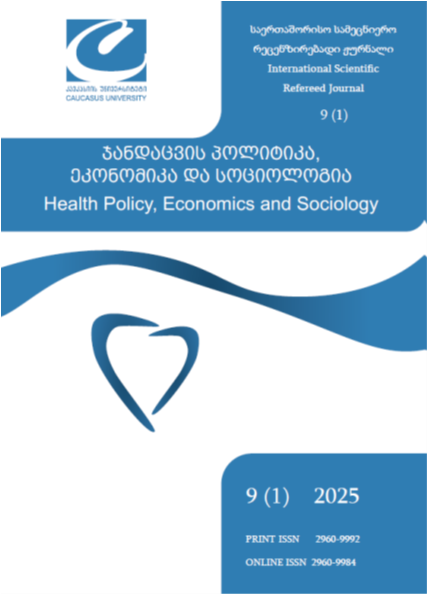საავადმყოფოს ხარისხის აგრეგირებული ინდექსი ხელმისაწვდომობისა და აქტივობის ტრადიციულ მონაცემებზე დაყრდნობით: დინამიკის ამსახველი მიდგომა
DOI:
https://doi.org/10.52340/healthecosoc.2025.09.01.07საკვანძო სიტყვები:
ინტერაქტიული ინსტრუმენტი, საავადმყოფოს მეტრიკა, აგრეგირებული მაჩვენებელიანოტაცია
შესავალი: საავადმყოფოების საქმიანობის შედარების ორ ძირითად საყრდენს – თეორიულს (პრინციპები და განხორციელებადობა) და პრაქტიკულს (სტანდარტიზებული და შედარებადი ინდიკატორები, ასევე ანგარიშგების შესაძლებლობები) – თუ გავითვალისწინებთ, შესაძლებელია წარმოვიდგინოთ პირამიდა. მისი მწვერვალი რჩეული, მაღალი ხარისხის საავადმყოფოებისთვის არის დაცული, მაშინ როცა საფუძველს სხვა კლინიკები ქმნიან, რომლებიც ყველა საავადმყოფოსთვის შეიძლება საერთო შედარების ბაზად იქცეს. ჩვენ გამოვიყენეთ სამი საავადმყოფოს მაჩვენებელი ტირანას საუნივერსიტეტო საავადმყოფოს ცენტრის მონაცემებიდან: ALOS (პაციენტის საშუალო ხანგრძლივობა სტაციონარში), BOR (საწოლების დატვირთვის მაჩვენებელი) და CM (მთლიანი სიკვდილიანობა). საბოლოო მონაცემთა ბაზა მოიცავდა 730 დაკვირვებას 51 კლინიკის ფარგლებში, 2005 წლის იანვრიდან 2019 წლის დეკემბრამდე. მეთოდი: ყველა მონაცემი წარმოდგენილი იყო როგორც მიმდინარე წლის მაჩვენებლის შეფარდება მონაცემთა ბაზაში არსებული წინა წლების საშუალო მნიშვნელობასთან. ALOS-ის მაჩვენებლის შეფარდება, BOR-ის მაჩვენებლის შეფარდება და CM-ის მაჩვენებლის შეფარდება წარმოადგენდა ახალ სტანდარტიზებულ მეტრიკებს, რომლებიც შესაძლებელს ხდიდა კლინიკების შედარებას ერთმანეთთან, თითოეული კლინიკის ისტორიულ მონაცემებთან შედარებით. ამ სამი მეტრიკის ჯამი ქმნის აგრეგირებულ მაჩვენებელს (Aggregated Rate) — უნიკალურ მნიშვნელობას თითოეული კლინიკისთვის, რომელიც შეიძლება გამოყენებულ იქნეს სხვებთან შედარებისთვის. რაც უფრო მაღალია ეს მაჩვენებელი, მით უფრო დაბალია კლინიკის ხარისხი. შედეგები: აგრეგირებული მაჩვენებელი, 2019 წლის მონაცემების გამოყენებით, კლასიფიცირებს კლინიკებს ხარისხის სკალაზე, რომელიც მერყეობს 1.54-დან 5.9-მდე. ანალოგიური მეთოდით შეფასდა მნიშვნელოვანი ICD-9-ის სამნიშნა დიაგნოზებიც — მაჩვენებლები მერყეობს 0.48-დან (ქრონიკული იშემიური გულსისხლძარღვთა დაავადების სხვა ფორმები) 1.38-მდე (მწვავე აპენდიციტი). დასკვნები: რეკომენდირებულია აგრეგირებული მაჩვენებლის (Aggregated Rate) ინტერაქტიული აპლიკაციის შექმნა, როგორც საავადმყოფოს ხარისხის მაჩვენებელზე დაფუძნებულ შეფასების ინსტრუმენტზე.
წყაროები
Akshija, I., & Dibra, A. (2018). Hospital doors under pressure: policies and trends in the major tertiary care hospital in Albania. Il Giornale di chirurgia, 34(5), 265–271.
Akshija, I. (2023). Incidence and prevalence of psychotic disorders, a county population study of Tirana Hospital Admissions. Journal of Health Policy & Outcomes Research, (1), 48–56. https://doi.org/10.7365/jhpor.2023.1.7
Aloh, H. E., Onwujekwe, O. E., Aloh, O. G., & Nweke, C. J. (2020). Is the bed turnover rate a good metric for hospital-scale efficiency? A measure of resource utilization rate for hospitals in Southeast Nigeria. Cost effectiveness and resource allocation: C/E, 18, 21. https://doi.org/10.1186/s12962-020-00216-w
Barjoan, E. M., Allouche, J., Legueult, K., Géloen, C., Prouvost-Keller, B., & Pradier, C. (2022). Hospitalisation avec ou pour COVID-19: quel indicateur de surveillance choisir? Sante publique (Vandoeuvre-les-Nancy, France), 33(5), 725–728. https://doi.org/10.3917/spub.215.0725
Bay, K. S., Toll, K. A., & Kerr, J. R. (1989). Utilisation of acute care hospital beds by levels of care. Health services management research, 2(2), 133–145. https://doi.org/10.1177/095148488900200205
Bhatia, D., Chaudhari, P. K., Chaudhary, B., Sharma, S., & Dhingra, K. (2023). A Guide to Hospital Administration and Planning. Springer Nature.
Bosque-Mercader, L., & Siciliani, L. (2022). The association between bed occupancy rates and hospital quality in the English National Health Service. The European Journal of Health Economics, 24(2), 209–236. https://doi.org/10.1007/s10198-022-01464-8
Braga, M. B., Fernandes, R. D. S., Souza, G. N., Jr, Rocha, J. E. C. D., Dolácio, C. J. F., Tavares, I. D. S., Jr, Pinheiro, R. R., Noronha, F. N., Rodrigues, L. L. S., Ramos, R. T. J., Carneiro, A. R., Brito, S. R., Diniz, H. A. C., Botelho, M. D. N., & Vallinoto, A. C. R. (2021). Artificial neural networks for short-term forecasting of cases, deaths, and hospital beds occupancy in the COVID-19 pandemic at the Brazilian Amazon. PloS one, 16(3), e0248161. https://doi.org/10.1371/journal.pone.0248161
Binger, T., Chen, H., & Harder, B. (2022). Hospital Rankings and Health Equity. JAMA, 328(18), 1805–1806. https://doi.org/10.1001/jama.2022.19001
Brunn, M., Kratz, T., Padget, M., Clément, M. C., & Smyrl, M. (2023). Why are there so many hospital beds in Germany? Health services management research, 36(1), 75–81. https://doi.org/10.1177/09514848221080691
Bulla A. (1977). Trends in tuberculosis hospital and sanatorium beds throughout the world (1960-1975). Evolution du nombre des lits des hôpitaux pour tuberculeux et des sanatoria dans le monde (1960-1975). World Health Statistics Report. Rapport de statistiques sanitaires mondiales, 30(1), 39–56.
Davis, G. E., Lowell, W. E., & Davis, G. L. (1998). Determining the number of state psychiatric hospital beds by measuring quality of care with artificial neural networks. American journal of medical quality: the official journal of the American College of Medical Quality, 13(1), 13–24. https://doi.org/10.1177/106286069801300103
Dokumenta statistikor për shëndetësinë. (2025). Shendetesia.gov.al. Retrieved April 23, 2025, from https://shendetesia.gov.al/dokumenta-statistikor-per-shendetesine/
Drake, R. E., & Wallach, M. A. (2019). Assessing the Optimal Number of Psychiatric Beds for a Region. Administration and policy in mental health, 46(6), 696–700. https://doi.org/10.1007/s10488-019-00954-x
Friebel, R., Fisher, R., Deeny, S. R., Gardner, T., Molloy, A., & Steventon, A. (2019). The implications of high bed occupancy rates on readmission rates in England: A longitudinal study. Health policy (Amsterdam, Netherlands), 123(8), 765–772. https://doi.org/10.1016/j.healthpol.2019.06.006
Graham, L. A., Mull, H. J., Wagner, T. H., Morris, M. S., Rosen, A. K., Richman, J. S., Whittle, J., Burns, E., Copeland, L. A., Itani, K. M. F., & Hawn, M. T. (2019). Comparison of a Potential Hospital Quality Metric With Existing Metrics for Surgical Quality-Associated Readmission. JAMA Network Open, 2(4), e191313. https://doi.org/10.1001/jamanetworkopen.2019.1313
Janke, A. T., Melnick, E. R., & Venkatesh, A. K. (2022). Hospital Occupancy and Emergency Department Boarding During the COVID-19 Pandemic. JAMA Network Open, 5(9), e2233964. https://doi.org/10.1001/jamanetworkopen.2022.33964
Johnson, D. (2023). Hospital quality: Implementing, managing, and sustaining an effective Quality Management System. Productivity Press.
Jones, R. P. (2023). Addressing the Knowledge Deficit in Hospital Bed Planning and Defining an Optimum Region for the Number of Different Types of Hospital Beds in an Effective Health Care System. International journal of environmental research and public health, 20(24), 7171. https://doi.org/10.3390/ijerph20247171
Hospital Beds for Children: A Shrinking Number and Poorly Distributed. (2023). The American journal of nursing, 123(2), 14. https://doi.org/10.1097/01.NAJ.0000919664.85184.ae
Hawsawi, T., & Abouammoh, N. (2022). Distribution of hospital beds across Saudi Arabia from 2015 to 2019: a cross-sectional study. Eastern Mediterranean health journal = La revue de sante de la Mediterranee orientale = al-Majallah al-sihhiyah li-sharq al-mutawassit, 28(1), 23–30. https://doi.org/10.26719/emhj.22.003
Lagoe, R. J. (1998). Basic statistics for clinical pathway evaluation. Nursing economics, 16(3), 125–131.
Lee, K. S., Min, H. S., Moon, J. Y., Lim, D., Kim, Y., Ko, E., Kim, Y. S., Kim, J., Lee, J., & Sung, H. K. (2022). Patient and hospital characteristics predict prolonged emergency department length of stay and in-hospital mortality: a nationwide analysis in Korea. BMC Emergency Medicine, 22(1), 183. https://doi.org/10.1186/s12873-022-00745-y
Magazine, M., Murphy, M., Schauer, D. P., & Wiggermann, N. (2021). Determining the Number of Bariatric Beds Needed in a U.S. Acute Care Hospital. HERD, 14(3), 14–26. https://doi.org/10.1177/19375867211012488
Matsumoto, H. H., Ogiya, R., & Matsuda, S. (2020). Association between variations in the number of hospital beds and inpatient chemo/radiotherapy for breast cancer: a study using a large claim database. Acta oncologica (Stockholm, Sweden), 59(9), 1072–1078. https://doi.org/10.1080/0284186X.2020.1787506
McKee, M., Merkur, S., Edwards, N., & Nolte, E. (2020). The changing role of the hospital in European Health Systems. Cambridge University Press.
Metcalfe, J., & Drake, R. (2020). National levels of human development and several mental hospital beds. Epidemiology and psychiatric sciences, 29, e167. https://doi.org/10.1017/S2045796020000761
Misra, A. K., & Maurya, J. (2023). Allocation of hospital beds on the emergence of a new infectious disease: A mathematical model. Chaos (Woodbury, N.Y.), 33(4), 043125. https://doi.org/10.1063/5.0133703
Misra, A. K., Maurya, J., & Sajid, M. (2022). Modeling the effect of time delay in the increment of a number of hospital beds to control an infectious disease. Mathematical biosciences and engineering: MBE, 19(11), 11628–11656. https://doi.org/10.3934/mbe.2022541
Murphy, M. E., & Noetscher, C. M. (1999). Reducing hospital inpatient lengths of stay. Journal of nursing care quality, Spec No, 40–54. https://doi.org/10.1097/00001786-199911000-00006
Najibi, S. M., Seyedi, S. H., Farhadi, P., Kharazmi, E., Shojaei, P., Delavari, S., Lotfi, F., & Kavosi, Z. (2022). Development of a model for predicting hospital bed shortages and optimal policies using a system dynamics approach. BMC Health Services Research, 22(1). https://doi.org/10.1186/s12913-022-08936-w
O'Brien, S. M., Delong, E. R., & Peterson, E. D. (2008). Impact of case volume on hospital performance assessment. Archives of internal medicine, 168(12), 1277–1284. https://doi.org/10.1001/archinte.168.12.1277
Oddleifson, A., Xu, X., Liu, P., Du, C., Spatz, E., & Desai, N. (2021). Association Between Hospital Performance Metrics and Market Share. JAMA Network Open, 4(10), e2130353. https://doi.org/10.1001/jamanetworkopen.2021.30353
Okayama, T., Usuda, K., Okazaki, E., & Yamanouchi, Y. (2020). Number of long-term inpatients in Japanese psychiatric care beds: trend analysis from the patient survey and the 630 survey. BMC psychiatry, 20(1), 522. https://doi.org/10.1186/s12888-020-02927-z
Pauly, M. V., & Wilson, P. (1986). Hospital output forecasts and the cost of empty hospital beds. Health services research, 21(3), 403–428.
Proudlove N. C. (2020). The 85% bed occupancy fallacy: The use, misuse, and insights of queuing theory. Health services management research, 33(3), 110–121. https://doi.org/10.1177/0951484819870936
Rechel, B. (2009). Investing in hospitals of the future. World Health Organization.
Reid, N., Gamage, T., Duckett, S. J., & Gray, L. C. (2023). Hospital utilisation in Australia, 1993-2020, with a focus on use by people over 75 years of age: a review of AIHW data. The Medical Journal of Australia, 219(3), 113–119. https://doi.org/10.5694/mja2.52026
Schubert, A., & Kemmerly, S. A. (2022). Optimizing widely reported hospital quality and safety grades: An Ochsner quality and value playbook. Springer.
Zjarri në Urgjencën e Qendrën Spitalore ‘Nënë Tereza’, Prokuroria Tiranë regjistron procedimin penal për veprën penale “Shkatërrimi pronës me zjarr.” (2024). Swiss Chiropractic Academy. Retrieved April 23, 2025, from https://www.pp.gov.al/Media/Njoftime_per_Shtyp/Zjarri_ne_Urgjencen_e_Qendren_Spitalore_Nene_Tereza_Prokuroria_Tirane_regjistron_procedimin_penal_per_vepren_penale_Shkaterrimi_prones_me_zjarr_19557.html
Vaughan Sarrazin, M.S., & Girotra, S. (2019). Exact Science and the Art of Approximating Quality in Hospital Performance Metrics. JAMA Network Open, 2(7), e197321. https://doi.org/10.1001/jamanetworkopen.2019.7321
Hornbrook, M. C., & Goldfarb, M. G. (1983). A partial test of a hospital behavioral model. Social science & medicine (1982), 17(10), 667–680. https://doi.org/10.1016/0277-9536(83)90373-8
Weimann, E., & Weimann, P. (2018). High performance in hospital management: A guideline for developing and developed countries. Springer Berlin.














